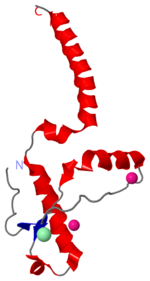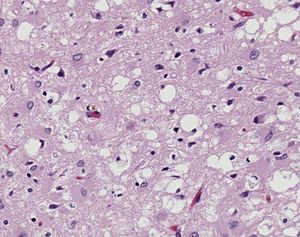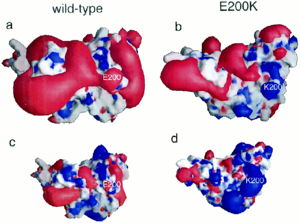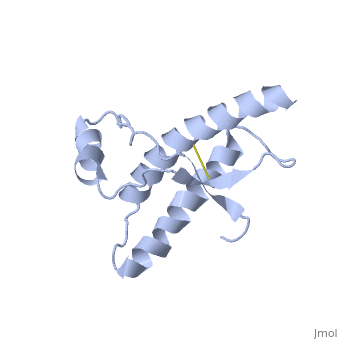Prions as a disease causing agent

Human Prion Protein in dimer form
1i4m
Caption: Holes in this sponge like brain tissue result from pockets of prion aggregation
[1]Prions are infectious or genetically coded misfolded proteins which act as templates upon which properly folded prion protein monomers can aggregate. Prions contain no nucleic acid such as other infectoius molecules or organisms. Human Prion Protein or Major Prion protein, exists as a normal constituent of human cells, found mostly in the brain[2] and is called PrPC.[3] PrPC is composed of mostly helix whereas the infectious form, PrPSc (also known as "scrapie" form), is composed of high percentage beta sheets.[3]
The diseases prions confer are neurodegenerative disorders which result from the large scale aggregation of these proteins. This "bubbles" of protein aggregates appear clear on a pictomicrograph and resemble a sponge. Bovine Spongiform Encephalopathy(BSE), or Mad Cow Disease, is a form of Transmissible Spongiform Encephalopathy caused by ingesting bovine prions. The first known cases of BSE occurred in the 1970's and have garnered a lot of media attention. Recently, feed bans in the United States and Canada have been adopted by the government in an attempt to stop the spread of BSE between cows. This bans the use of potential materials which would contain prion proteins, whether misfolded or wild-type. [4] For more information about the infections related to prions see Transmissible spongiform encephalopathy at Wikipedia.
Unfolding Mechanism
Currently, the mechanism by which a template prion unfolds the helices of a properly folded prion protein is unknown. Specific residues have been shown to either confer resistance or lend themselves to this unfolding.
PrPC natural monomer
This monomeric structure is the form of Major Prion Protein as it appears in a non-diseased individual. The majority of this 3D structure is and two small beta sheets.
The following residue alterations confer increased susceptibility to the unfolding of these alpha helices characteristic of spongiform encephalopathies.
Residue 129 Val-->Met confers increased susceptibility to contracting spongiform encephalopathies. The alteration from 129 valine to 129 methionine does not majorly change electrostatics as both are hydrophobic. The methionine group is bulkier however. Due to the limitations of viewing the monomeric form, , it does not offer a possible mechanism of unfolding or aggregation. This single residue, however has incredible actions. As of January 2010, only individuals with homozygous Metionine 129 had been diagnosed with infectious Creutzfeldt–Jakob disease.[5]
exhibit species specific residues. This region is most variable between species. Residue shifts in this section increase or decrease susceptibility from inter-species transmission of TSE's. The more similar this region is between species, the more likely each are able to transfer infectious prions between the two.[5]
The in the monomeric form must all be broken during the conformational change from PrPC to PrPSc. [6]
. This residue shift changes the surface electrostatic potential in a way which alters its interactions with other prion proteins as well as chaperone proteins. The Lys residue in position 200 is found in the infectious form of Creutzfeldt–Jakob disease. Those who have Lysine in the 200 position who live long enough will develop a spontaneous form of Creutzfeldt–Jakob disease.[7]

Caption: This shows (a&c) the electrostatic potential of wild-type Human Prion Protein with Glu200 and (b&d) the electrostatic potential of variant Lys200.
[7] PrPSc
The majority of this structure is .
The following residues are not visible in the PrPSc shown. These residues are not part of the beta sheets of the unraveled prion protein, yet they are important to the transference of TSEs. The dimer form of Human Prion Protein shows where these residues make their influence:
129 Val-->Met (susceptibility to Creutzfeldt–Jakob disease). Residues R164 to S170 (variable region between species)[5]
200 Glu-->Lys (present in infectious and spontaneous form of Creutzfeldt–Jakob disease)[7]
The Cystine residues which were formerly part of disulfide bonds have been reduced catalytically without any chemical reducing agent. [6]
Dimer Form
1i4m.
The , shown above, alter the function of Major Prion Protein's ability to re-fold, however their positions on the wild-type monomer and fully unfolded PrPSc, do not illustrate a clear mechanism for propagation. The dimer brings light to these residues' influence on the infectious qualities of PrPSc.
It is theorized from this dimeric structure that the dimerization is the first step in amyloid formation and the presence of these dimers could possibly speed up the aggregation of PrPSc.
The following interactions and residue switching portray possible catalytic sites:
Residues 129, and 164 to 170 are shown to exist right at the dimer interfaces and residue 200 exists at the switch region. The location of these residues within the dimer indicates that their key operation is found somewhere in the dimerization process. [5][6][7]
Helix 1 (Ser 143−Tyr 157) exists at the . Many nonpolar residues form Van der Waals attractions. Acidic and mostly negative residues are shown in blue. Basic and mostly positive residues are shown in red. The interactions between these also stabilize the dimer interface.
Helix 2 (Asn 171−Thr 188) is to the C-terminal helix 3 (Thr 199−Tyr 225). Van der Waals forces are here between such nonpolar residues as valine, isoleucene, and nonpolar sections as histadine, methionine, and glutamic acid.[6]
The (residues 189-198) is where the actual unfolding has taken place.
More Van der Waals and electrostatic forces occur between the of the same molecule. These interactions would not be able to occur in the monomer.
between the dimers exist at Thr188 O−Gly195 N, Thr190 O−Lys194 N and Thr192 O−Thr192 N
between Asp 202 and Thr 199 stabilize the dimeric structure.
form a hydrogen bond located at the end of helix 3 and near the switch region of the other chain, which allow the inter-chain interactions to be specific.
Due to the importance of initial dimerization in the formation of prion aggregates, the step of dimerization presents a known step for treatments to target.[6]




